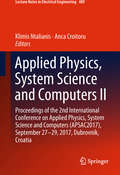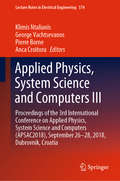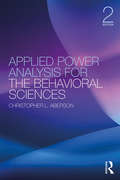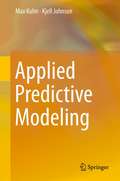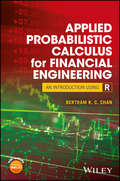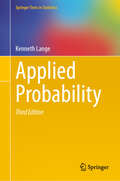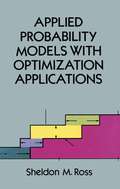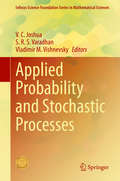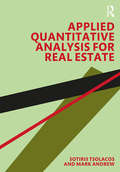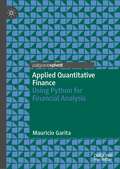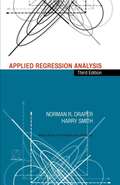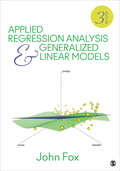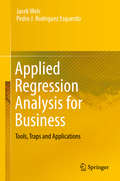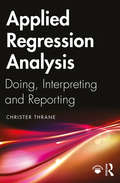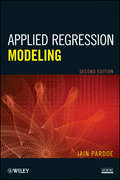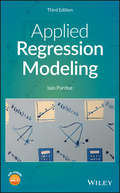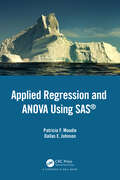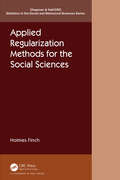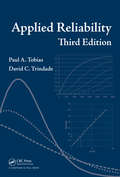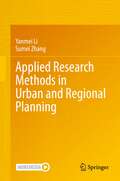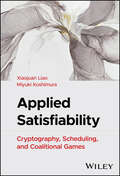- Table View
- List View
Applied Physics, System Science and Computers II: Proceedings of the 2nd International Conference on Applied Physics, System Science and Computers (APSAC2017), September 27-29, 2017, Dubrovnik, Croatia (Lecture Notes in Electrical Engineering #489)
by Klimis Ntalianis Anca CroitoruThis book reports on advanced theories and methods in three related fields of research: applied physics, system science and computers. It is organized in three parts, the first of which covers applied physics topics, including lasers and accelerators; condensed matter, soft matter and materials science; nanoscience and quantum engineering; atomic, molecular, optical and plasma physics; as well as nuclear and high-energy particle physics. It also addresses astrophysics, gravitation, earth and environmental science, as well as medical and biological physics. The second and third parts focus on advances in computers and system science, respectively, and report on automatic circuit control, power systems, computer communication, fluid mechanics, simulation and modeling, software engineering, data structures and applications of artificial intelligence among other areas. Offering a collection of contributions presented at the 2nd International Conference on Applied Physics, System Science and Computers (APSAC), held in Dubrovnik, Croatia on September 27–29, 2017, the book bridges the gap between applied physics and electrical engineering. It not only to presents new methods, but also promotes collaborations between different communities working on related topics at the interface between physics and engineering, with a special focus on communication, data modeling and visualization, quantum information, applied mechanics as well as bio and geophysics.
Applied Physics, System Science and Computers III: Proceedings of the 3rd International Conference on Applied Physics, System Science and Computers (APSAC2018), September 26-28, 2018, Dubrovnik, Croatia (Lecture Notes in Electrical Engineering #574)
by Pierre Borne Klimis Ntalianis Anca Croitoru George VachtsevanosThis book reports on advanced theories and methods in three related fields of research: applied physics, system science and computers. The first part covers applied physics topics, such as lasers and accelerators; fluid dynamics, optics and spectroscopy, among others. It also addresses astrophysics, security, and medical and biological physics. The second part focuses on advances in computers, such as those in the area of social networks, games, internet of things, deep learning models and more. The third part is especially related to systems science, covering swarm intelligence, smart cities, complexity and more. Advances in and application of computer communication, artificial intelligence, data analysis, simulation and modeling are also addressed. The book offers a collection of contributions presented at the 3nd International Conference on Applied Physics, System Science and Computers (APSAC), held in Dubrovnik, Croatia on September 26–28, 2018. Besides presenting new methods, it is also intended to promote collaborations between different communities working on related topics at the interface between physics, computer science and engineering.
Applied Power Analysis for the Behavioral Sciences: 2nd Edition
by Christopher L. AbersonApplied Power Analysis for the Behavioral Sciences is a practical "how-to" guide to conducting statistical power analyses for psychology and related fields. The book provides a guide to conducting analyses that is appropriate for researchers and students, including those with limited quantitative backgrounds. With practical use in mind, the text provides detailed coverage of topics such as how to estimate expected effect sizes and power analyses for complex designs. The topical coverage of the text, an applied approach, in-depth coverage of popular statistical procedures, and a focus on conducting analyses using R make the text a unique contribution to the power literature. To facilitate application and usability, the text includes ready-to-use R code developed for the text. An accompanying R package called pwr2ppl (available at https://github.com/chrisaberson/pwr2ppl) provides tools for conducting power analyses across each topic covered in the text.
Applied Predictive Modeling
by Max Kuhn Kjell JohnsonThis text is intended for a broad audience as both an introduction to predictive models as well as a guide to applying them. Non-mathematical readers will appreciate the intuitive explanations of the techniques while an emphasis on problem-solving with real data across a wide variety of applications will aid practitioners who wish to extend their expertise. Readers should have knowledge of basic statistical ideas, such as correlation and linear regression analysis. While the text is biased against complex equations, a mathematical background is needed for advanced topics. Dr. Kuhn is a Director of Non-Clinical Statistics at Pfizer Global R&D in Groton Connecticut. He has been applying predictive models in the pharmaceutical and diagnostic industries for over 15 years and is the author of a number of R packages. Dr. Johnson has more than a decade of statistical consulting and predictive modeling experience in pharmaceutical research and development. He is a co-founder of Arbor Analytics, a firm specializing in predictive modeling and is a former Director of Statistics at Pfizer Global R&D. His scholarly work centers on the application and development of statistical methodology and learning algorithms.
Applied Probabilistic Calculus for Financial Engineering: An Introduction Using R
by Bertram K. ChanIllustrates how R may be used successfully to solve problems in quantitative finance Applied Probabilistic Calculus for Financial Engineering: An Introduction Using R provides R recipes for asset allocation and portfolio optimization problems. It begins by introducing all the necessary probabilistic and statistical foundations, before moving on to topics related to asset allocation and portfolio optimization with R codes illustrated for various examples. This clear and concise book covers financial engineering, using R in data analysis, and univariate, bivariate, and multivariate data analysis. It examines probabilistic calculus for modeling financial engineering—walking the reader through building an effective financial model from the Geometric Brownian Motion (GBM) Model via probabilistic calculus, while also covering Ito Calculus. Classical mathematical models in financial engineering and modern portfolio theory are discussed—along with the Two Mutual Fund Theorem and The Sharpe Ratio. The book also looks at R as a calculator and using R in data analysis in financial engineering. Additionally, it covers asset allocation using R, financial risk modeling and portfolio optimization using R, global and local optimal values, locating functional maxima and minima, and portfolio optimization by performance analytics in CRAN. • Covers optimization methodologies in probabilistic calculus for financial engineering • Answers the question: What does a "Random Walk" Financial Theory look like? • Covers the GBM Model and the Random Walk Model • Examines modern theories of portfolio optimization, including The Markowitz Model of Modern Portfolio Theory (MPT), The Black-Litterman Model, and The Black-Scholes Option Pricing Model Applied Probabilistic Calculus for Financial Engineering: An Introduction Using R is an ideal reference for professionals and students in economics, econometrics, and finance, as well as for financial investment quants and financial engineers. BERTRAM K. C. CHAN, PhD, is Consulting Biostatistician at the Loma Linda University Health, School of Medicine, Loma Linda, CA. Dr. Chan is also Software Development and Forum Lecturer at the School of Public Health, LLUH Department of Biostatistics and Epidemiology.
Applied Probability (Springer Texts in Statistics)
by Kenneth LangeApplied Probability presents a unique blend of theory and applications, with special emphasis on mathematical modeling, computational techniques, and examples from the biological sciences. Chapter 1 reviews elementary probability and provides a brief survey of relevant results from measure theory. Chapter 2 is an extended essay on calculating expectations. Chapter 3 deals with probabilistic applications of convexity, inequalities, and optimization theory. Chapters 4 and 5 touch on combinatorics and combinatorial optimization. Chapters 6 through 11 present core material on stochastic processes. If supplemented with appropriate sections from Chapters 1 and 2, there is sufficient material for a traditional semester-long course in stochastic processes covering the basics of Poisson processes, Markov chains, branching processes, martingales, and diffusion processes. This third edition includes new topics and many worked exercises. The new chapter on entropy stresses Shannon entropy and its mathematical applications. New sections in existing chapters explain the Chinese restaurant problem, the infinite alleles model, saddlepoint approximations, and recurrence relations. The extensive list of new problems pursues topics such as random graph theory omitted in the previous editions. Computational probability receives even greater emphasis than earlier. Some of the solved problems are coding exercises, and Julia code is provided. Mathematical scientists from a variety of backgrounds will find Applied Probability appealing as a reference. This updated edition can serve as a textbook for graduate students in applied mathematics, biostatistics, computational biology, computer science, physics, and statistics. Readers should have a working knowledge of multivariate calculus, linear algebra, ordinary differential equations, and elementary probability theory.
Applied Probability Models with Optimization Applications
by Sheldon M. Ross"A clarity of style and a conciseness of treatment which students will find most welcome. The material is valuable and well organized ... an excellent introduction to applied probability." -- Journal of the American Statistical Association. This book offers a concise introduction to some of the stochastic processes that frequently arise in applied probability. Emphasis is on optimization models and methods, particularly in the area of decision processes. After reviewing some basic notions of probability theory and stochastic processes, the author presents a useful treatment of the Poisson process, including compound and nonhomogeneous Poisson processes. Subsequent chapters deal with such topics as renewal theory and Markov chains; semi-Markov, Markov renewal, and regenerative processes; inventory theory; and Brownian motion and continuous time optimization models.Each chapter is followed by a section of useful problems that illustrate and complement the text. There is also a short list of relevant references at the end of every chapter. Students will find this a largely self-contained text that requires little previous knowledge of the subject. It is especially suited for a one-year course in applied probability at the advanced undergraduate or beginning postgraduate level. 1970 edition.
Applied Probability and Stochastic Processes
by Frank BeicheltApplied Probability and Stochastic Processes, Second Edition presents a self-contained introduction to elementary probability theory and stochastic processes with a special emphasis on their applications in science, engineering, finance, computer science, and operations research. It covers the theoretical foundations for modeling time-dependent random phenomena in these areas and illustrates applications through the analysis of numerous practical examples. The author draws on his 50 years of experience in the field to give your students a better understanding of probability theory and stochastic processes and enable them to use stochastic modeling in their work. New to the Second Edition Completely rewritten part on probability theory—now more than double in size New sections on time series analysis, random walks, branching processes, and spectral analysis of stationary stochastic processes Comprehensive numerical discussions of examples, which replace the more theoretically challenging sections Additional examples, exercises, and figures Presenting the material in a student-friendly, application-oriented manner, this non-measure theoretic text only assumes a mathematical maturity that applied science students acquire during their undergraduate studies in mathematics. Many exercises allow students to assess their understanding of the topics. In addition, the book occasionally describes connections between probabilistic concepts and corresponding statistical approaches to facilitate comprehension. Some important proofs and challenging examples and exercises are also included for more theoretically interested readers.
Applied Probability and Stochastic Processes (Infosys Science Foundation Series)
by Vladimir M. Vishnevsky V. C. Joshua S. R. S. VaradhanThis book gathers selected papers presented at the International Conference on Advances in Applied Probability and Stochastic Processes, held at CMS College, Kerala, India, on 7–10 January 2019. It showcases high-quality research conducted in the field of applied probability and stochastic processes by focusing on techniques for the modelling and analysis of systems evolving with time. Further, it discusses the applications of stochastic modelling in queuing theory, reliability, inventory, financial mathematics, operations research, and more. This book is intended for a broad audience, ranging from researchers interested in applied probability, stochastic modelling with reference to queuing theory, inventory, and reliability, to those working in industries such as communication and computer networks, distributed information systems, next-generation communication systems, intelligent transportation networks, and financial markets.
Applied Quantitative Analysis for Real Estate
by Sotiris Tsolacos Mark AndrewTo fully function in today’s global real estate industry, students and professionals increasingly need to understand how to implement essential and cutting-edge quantitative techniques. This book presents an easy-to-read guide to applying quantitative analysis in real estate aimed at non-cognate undergraduate and masters students, and meets the requirements of modern professional practice. Through case studies and examples illustrating applications using data sourced from dedicated real estate information providers and major firms in the industry, the book provides an introduction to the foundations underlying statistical data analysis, common data manipulations and understanding descriptive statistics, before gradually building up to more advanced quantitative analysis, modelling and forecasting of real estate markets. Our examples and case studies within the chapters have been specifically compiled for this book and explicitly designed to help the reader acquire a better understanding of the quantitative methods addressed in each chapter. Our objective is to equip readers with the skills needed to confidently carry out their own quantitative analysis and be able to interpret empirical results from academic work and practitioner studies in the field of real estate and in other asset classes. Both undergraduate and masters level students, as well as real estate analysts in the professions, will find this book to be essential reading.
Applied Quantitative Finance: Using Python for Financial Analysis
by Mauricio GaritaThis book provides both conceptual knowledge of quantitative finance and a hands-on approach to using Python. It begins with a description of concepts prior to the application of Python with the purpose of understanding how to compute and interpret results. This book offers practical applications in the field of finance concerning Python, a language that is more and more relevant in the financial arena due to big data. This will lead to a better understanding of finance as it gives a descriptive process for students, academics and practitioners.
Applied Regression Analysis (Wiley Series in Probability and Statistics #326)
by Norman R. Draper Harry SmithAn outstanding introduction to the fundamentals of regression analysis-updated and expanded The methods of regression analysis are the most widely used statistical tools for discovering the relationships among variables. This classic text, with its emphasis on clear, thorough presentation of concepts and applications, offers a complete, easily accessible introduction to the fundamentals of regression analysis. Assuming only a basic knowledge of elementary statistics, Applied Regression Analysis, Third Edition focuses on the fitting and checking of both linear and nonlinear regression models, using small and large data sets, with pocket calculators or computers. This Third Edition features separate chapters on multicollinearity, generalized linear models, mixture ingredients, geometry of regression, robust regression, and resampling procedures. Extensive support materials include sets of carefully designed exercises with full or partial solutions and a series of true/false questions with answers. All data sets used in both the text and the exercises can be found on the companion disk at the back of the book. For analysts, researchers, and students in university, industrial, and government courses on regression, this text is an excellent introduction to the subject and an efficient means of learning how to use a valuable analytical tool. It will also prove an invaluable reference resource for applied scientists and statisticians.
Applied Regression Analysis and Experimental Design (Statistics: A Series Of Textbooks And Monographs #62)
by Richard J. Brook Gregory C. ArnoldFor a solid foundation of important statistical methods, the concise, single-source text unites linear regression with analysis of experiments and provides students with the practical understanding needed to apply theory in real data analysis problems.Stressing principles while keeping computational and theoretical details at a manageable level, Applied Regression Analysis and Experimental Design features an emphasis on vector geometry and least squares to unify and provide an intuitive basis for most topics covered… abundant examples and exercises using real-life data sets clearly illustrating practical of data analysis…essential exposure to MINITAB and GENSTAT computer packages , including computer printouts…and important background material such as vector and matrix properties and the distributional properties of quadratic forms.Designed to make theory work for students, this clearly written, easy-to-understand work serves as the ideal texts for courses Regression, Experimental Design, and Linear Models in a broad range of disciplines. Moreover, applied statisticians will find the book a useful reference for the general application of the linear model.
Applied Regression Analysis and Generalized Linear Models
by Dr John FoxCombining a modern, data-analytic perspective with a focus on applications in the social sciences, the Third Edition of Applied Regression Analysis and Generalized Linear Models provides in-depth coverage of regression analysis, generalized linear models, and closely related methods, such as bootstrapping and missing data. Updated throughout, this Third Edition includes new chapters on mixed-effects models for hierarchical and longitudinal data. Although the text is largely accessible to readers with a modest background in statistics and mathematics, author John Fox also presents more advanced material in optional sections and chapters throughout the book.
Applied Regression Analysis and Generalized Linear Models
by Dr John FoxCombining a modern, data-analytic perspective with a focus on applications in the social sciences, the Third Edition of Applied Regression Analysis and Generalized Linear Models provides in-depth coverage of regression analysis, generalized linear models, and closely related methods, such as bootstrapping and missing data. Updated throughout, this Third Edition includes new chapters on mixed-effects models for hierarchical and longitudinal data. Although the text is largely accessible to readers with a modest background in statistics and mathematics, author John Fox also presents more advanced material in optional sections and chapters throughout the book.
Applied Regression Analysis and Generalized Linear Models
by John FoxCombining a modern, data-analytic perspective with a focus on applications in the social sciences, the Third Edition of Applied Regression Analysis and Generalized Linear Models provides in-depth coverage of regression analysis, generalized linear models, and closely related methods, such as bootstrapping and missing data. <P><P> Updated throughout, this Third Edition includes new chapters on mixed-effects models for hierarchical and longitudinal data. Although the text is largely accessible to readers with a modest background in statistics and mathematics, author John Fox also presents more advanced material in optional sections and chapters throughout the book.
Applied Regression Analysis for Business: Tools, Traps and Applications
by Jacek Welc Pedro J. Rodriguez EsquerdoThis book offers hands-on statistical tools for business professionals by focusing on the practical application of a single-equation regression. The authors discuss commonly applied econometric procedures, which are useful in building regression models for economic forecasting and supporting business decisions. A significant part of the book is devoted to traps and pitfalls in implementing regression analysis in real-world scenarios. The book consists of nine chapters, the final two of which are fully devoted to case studies. Today's business environment is characterised by a huge amount of economic data. Making successful business decisions under such data-abundant conditions requires objective analytical tools, which can help to identify and quantify multiple relationships between dozens of economic variables. Single-equation regression analysis, which is discussed in this book, is one such tool. The book offers a valuable guide and is relevant in various areas of economic and business analysis, including marketing, financial and operational management.
Applied Regression Analysis: Doing, Interpreting and Reporting
by Christer ThraneThis book is an introduction to regression analysis, focusing on the practicalities of doing regression analysis on real-life data. Contrary to other textbooks on regression, this book is based on the idea that you do not necessarily need to know much about statistics and mathematics to get a firm grip on regression and perform it to perfection. This non-technical point of departure is complemented by practical examples of real-life data analysis using statistics software such as Stata, R and SPSS. Parts 1 and 2 of the book cover the basics, such as simple linear regression, multiple linear regression, how to interpret the output from statistics programs, significance testing and the key regression assumptions. Part 3 deals with how to practically handle violations of the classical linear regression assumptions, regression modeling for categorical y-variables and instrumental variable (IV) regression. Part 4 puts the various purposes of, or motivations for, regression into the wider context of writing a scholarly report and points to some extensions to related statistical techniques. This book is written primarily for those who need to do regression analysis in practice, and not only to understand how this method works in theory. The book’s accessible approach is recommended for students from across the social sciences.
Applied Regression Modeling
by Iain PardoePraise for the First Edition"The attention to detail is impressive. The book is very well written and the author is extremely careful with his descriptions . . . the examples are wonderful." --The American StatisticianFully revised to reflect the latest methodologies and emerging applications, Applied Regression Modeling, Second Edition continues to highlight the benefits of statistical methods, specifically regression analysis and modeling, for understanding, analyzing, and interpreting multivariate data in business, science, and social science applications.The author utilizes a bounty of real-life examples, case studies, illustrations, and graphics to introduce readers to the world of regression analysis using various software packages, including R, SPSS, Minitab, SAS, JMP, and S-PLUS. In a clear and careful writing style, the book introduces modeling extensions that illustrate more advanced regression techniques, including logistic regression, Poisson regression, discrete choice models, multilevel models, and Bayesian modeling.In addition, the Second Edition features clarification and expansion of challenging topics, such as:Transformations, indicator variables, and interactionTesting model assumptionsNonconstant varianceAutocorrelationVariable selection methodsModel building and graphical interpretationThroughout the book, datasets and examples have been updated and additional problems are included at the end of each chapter, allowing readers to test their comprehension of the presented material. In addition, a related website features the book's datasets, presentation slides, detailed statistical software instructions, and learning resources including additional problems and instructional videos.With an intuitive approach that is not heavy on mathematical detail, Applied Regression Modeling, Second Edition is an excellent book for courses on statistical regression analysis at the upper-undergraduate and graduate level. The book also serves as a valuable resource for professionals and researchers who utilize statistical methods for decision-making in their everyday work.
Applied Regression Modeling: A Business Approach
by Iain PardoeMaster the fundamentals of regression without learning calculus with this one-stop resource The newly and thoroughly revised 3rd Edition of Applied Regression Modeling delivers a concise but comprehensive treatment of the application of statistical regression analysis for those with little or no background in calculus. Accomplished instructor and author Dr. Iain Pardoe has reworked many of the more challenging topics, included learning outcomes and additional end-of-chapter exercises, and added coverage of several brand-new topics including multiple linear regression using matrices. The methods described in the text are clearly illustrated with multi-format datasets available on the book's supplementary website. In addition to a fulsome explanation of foundational regression techniques, the book introduces modeling extensions that illustrate advanced regression strategies, including model building, logistic regression, Poisson regression, discrete choice models, multilevel models, Bayesian modeling, and time series forecasting. Illustrations, graphs, and computer software output appear throughout the book to assist readers in understanding and retaining the more complex content. Applied Regression Modeling covers a wide variety of topics, like: Simple linear regression models, including the least squares criterion, how to evaluate model fit, and estimation/prediction Multiple linear regression, including testing regression parameters, checking model assumptions graphically, and testing model assumptions numerically Regression model building, including predictor and response variable transformations, qualitative predictors, and regression pitfalls Three fully described case studies, including one each on home prices, vehicle fuel efficiency, and pharmaceutical patches Perfect for students of any undergraduate statistics course in which regression analysis is a main focus, Applied Regression Modeling also belongs on the bookshelves of non-statistics graduate students, including MBAs, and for students of vocational, professional, and applied courses like data science and machine learning.
Applied Regression and ANOVA Using SAS
by Dallas E. Johnson Patricia F. MoodieApplied Regression and ANOVA Using SAS® has been written specifically for non-statisticians and applied statisticians who are primarily interested in what their data are revealing. Interpretation of results are key throughout this intermediate-level applied statistics book. The authors introduce each method by discussing its characteristic features, reasons for its use, and its underlying assumptions. They then guide readers in applying each method by suggesting a step-by-step approach while providing annotated SAS programs to implement these steps.Those unfamiliar with SAS software will find this book helpful as SAS programming basics are covered in the first chapter. Subsequent chapters give programming details on a need-to-know basis. Experienced as well as entry-level SAS users will find the book useful in applying linear regression and ANOVA methods, as explanations of SAS statements and options chosen for specific methods are provided.Features:•Statistical concepts presented in words without matrix algebra and calculus•Numerous SAS programs, including examples which require minimum programming effort to produce high resolution publication-ready graphics•Practical advice on interpreting results in light of relatively recent views on threshold p-values, multiple testing, simultaneous confidence intervals, confounding adjustment, bootstrapping, and predictor variable selection•Suggestions of alternative approaches when a method’s ideal inference conditions are unreasonable for one’s dataThis book is invaluable for non-statisticians and applied statisticians who analyze and interpret real-world data. It could be used in a graduate level course for non-statistical disciplines as well as in an applied undergraduate course in statistics or biostatistics.
Applied Regularization Methods for the Social Sciences (Chapman & Hall/CRC Statistics in the Social and Behavioral Sciences)
by Holmes FinchResearchers in the social sciences are faced with complex data sets in which they have relatively small samples and many variables (high dimensional data). Unlike the various technical guides currently on the market, Applied Regularization Methods for the Social Sciences provides and overview of a variety of models alongside clear examples of hands-on application. Each chapter in this book covers a specific application of regularization techniques with a user-friendly technical description, followed by examples that provide a thorough demonstration of the methods in action. Key Features: Description of regularization methods in a user friendly and easy to read manner Inclusion of regularization-based approaches for a variety of statistical analyses commonly used in the social sciences, including both univariate and multivariate models Fully developed extended examples using multiple software packages, including R, SAS, and SPSS Website containing all datasets and software scripts used in the examples Inclusion of both frequentist and Bayesian regularization approaches Application exercises for each chapter that instructors could use in class, and independent researchers could use to practice what they have learned from the book
Applied Reliability
by Paul A. Tobias David TrindadeSince the publication of the second edition of Applied Reliability in 1995, the ready availability of inexpensive, powerful statistical software has changed the way statisticians and engineers look at and analyze all kinds of data. Problems in reliability that were once difficult and time consuming even for experts can now be solved with a few well
Applied Research Methods in Urban and Regional Planning
by Yanmei Li Sumei ZhangThis book introduces the fundamentals of research methods and how they apply to the discipline of urban and regional planning. Written at a level appropriate for upper-level undergraduate and beginning master’s level students, the text fills a gap in the literature for textbooks on urban planning. Additionally, the book can be used as a reference for planning practitioners and researchers when analyzing quantitative and qualitative data in urban and regional planning and related fields.The volume does not assume advanced knowledge of mathematical formulas. Rather, it begins with the essentials of research methods, such as the identification of the research problems in planning, the literature review, data collection and presentation, descriptive data analysis, and report of findings. Its discipline-specific topics include field research methods, qualitative data analysis, economic and demographic analysis, evaluation research, and methods in sub-disciplines such as land use planning, transportation planning, environmental planning, and housing analysis. Designed with instruction in mind, this book features downloadable materials, including learning outcomes, chapter highlights, chapter review questions, datasets, and certain Excel models. Students will be able to download review questions to enhance the learning process and datasets to practice methods.
Applied Satisfiability: Cryptography, Scheduling, and Coalitional Games
by Xiaojuan Liao Miyuki KoshimuraApply satisfiability to a range of difficult problems The Boolean Satisfiability Problem (SAT) is one of the most famous and widely-studied problems in Boolean logic. Optimization versions of this problem include the Maximum Satisfiability Problem (MaxSAT) and its extensions, such as partial MaxSAT and weighted MaxSAT, which assess whether, and to what extent, a solution satisfies a given set of problems. Numerous applications of SAT and MaxSAT have emerged in fields related to logic and computing technology. Applied Satisfiability: Cryptography, Scheduling, and Coalitional Games outlines some of these applications in three specific fields. It offers a huge range of SAT applications and their possible impacts, allowing readers to tackle previously challenging optimization problems with a new selection of tools. Professionals and researchers in this field will find the scope of their computational solutions to otherwise intractable problems vastly increased. Applied Satisfiability readers will also find: Coding and problem-solving skills applicable to a variety of fieldsSpecific experiments and case studies that demonstrate the effectiveness of satisfiability-aided methodsChapters covering topics including cryptographic key recovery, various forms of scheduling, coalition structure generation, and many more Applied Satisfiability is ideal for researchers, graduate students, and practitioners in these fields looking to bring a new skillset to bear in their studies and careers.
